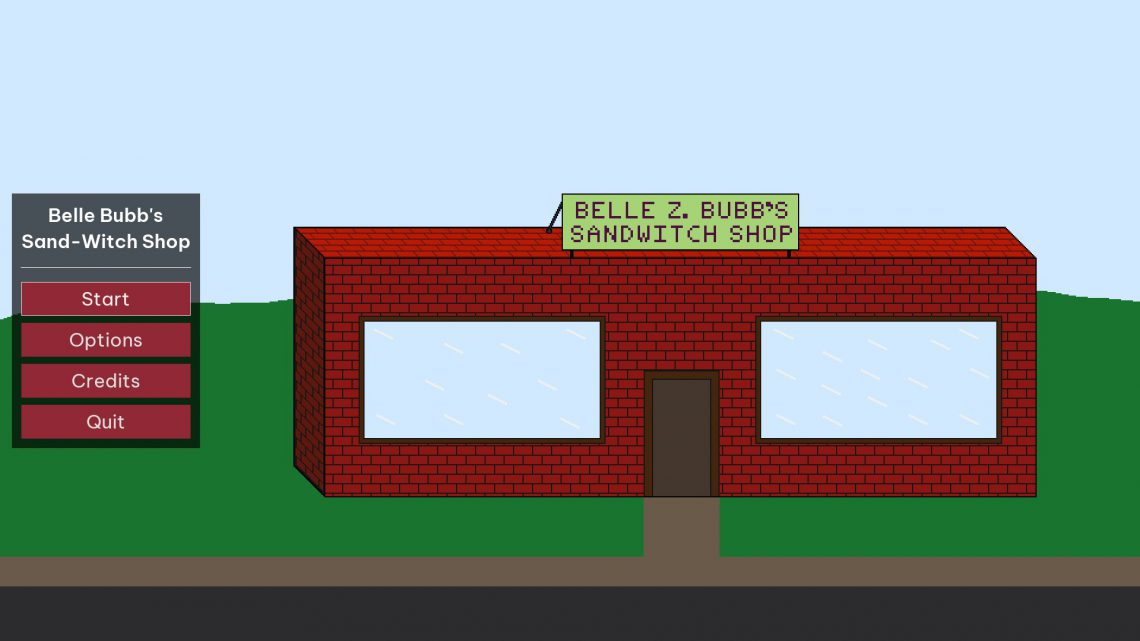Rebecca and I have spent the last half year working on the same game: Dice Tower (the full release). We hit a milestone of getting the game ready enough to show at a local playtest livestream, and I really wanted to take a break from Dice Tower development. The two of us decided to participate in another game jam; it would let us try making something different, and possibly something that would be worth continuing after Dice Tower was finished.
Participating in more game jams was something we’d intended to do after GMTK Game Jam last year, but we spent so much time focused on Dice Tower that we never made time for it.
After some research into game jams happening at the time, we chose to enter Godot Wild Jam 54. It’s a game jam where only Godot engine-made games were allowed, so we’d get a chance to see other games made in that engine. It was a smaller size game jam than others we’d entered in the past, so the odds that people would play our game (and leave feedback) was higher. Finally, the length of the jam was nine days, and we thought that would allow us to better fit jam work in alongside our normal day job and family responsibilities without taking too much time off.
The game we created was Belle Bubb’s Sand-Witch Shop, and it was about working in a sandwich shop making “cursed sandwiches” (fitting the jam’s theme of “curses”) through 2D drag-and-drop gameplay. Sadly, we were unable to finish the game due to a convergence of multiple major issues; that said, those issues provided great insight into how to get better at making games, so I don’t think our efforts were wasted.
I’ll identify what those issues were, explain why they were problematic, and explain how I’m going to learn from them to become a better game developer.
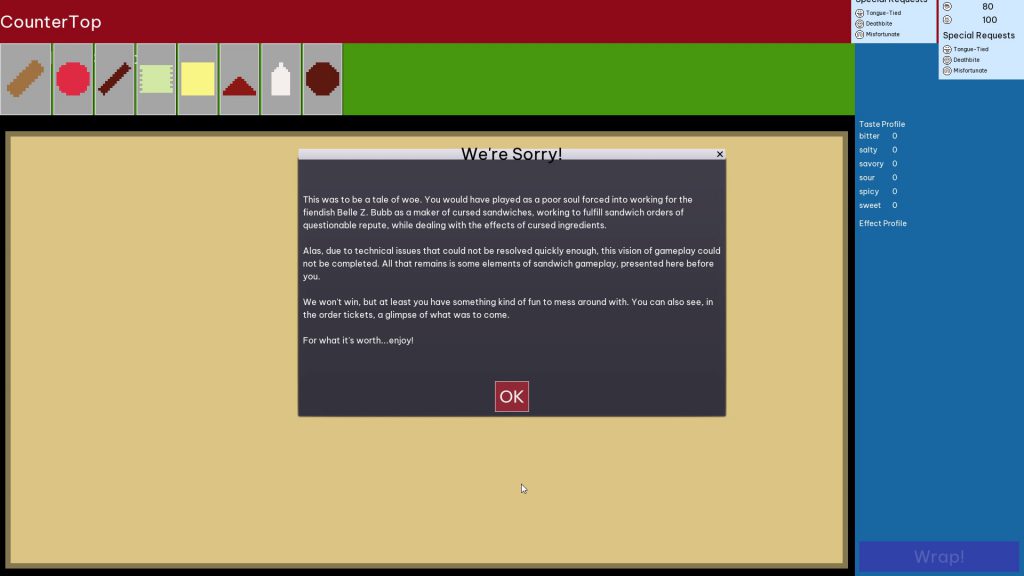
Issue: Isolated Tests
The gameplay for Belle Bubb’s Sand-Witch Shop involved doing new kinds of things that I was less familiar with, like drag and drop mechanics, evaluating what constituted a “sandwich”, and having ingredients that could interact with one another both during sandwich assembly and during sandwich consumption (aka “eating”). I chose to try and build each system in isolation and test that each worked well enough before moving on to others.
Creating all the systems in isolation meant there was no gameplay loop for the majority of the game’s development, so there couldn’t be any testing around whether the game was actually fun. Sure, dragging ingredients around and having them interact with one another was cool, but without evaluating them it was just an aimless sandbox experience. Testing the systems independently also meant I couldn’t see how well they’d interface with one another. This had catastrophic consequences when I encountered fatal issues with those systems once they were brought together.
Lesson Learned: No More Isolated Tests
I like making isolated tests because it’s simpler for me to wrap my head around them; I also don’t have to immediately worry about making them work as part of a whole. However, this is twice now that waiting to integrate systems until later in the project has resulted in slower progress. The jam version of Dice Tower was able to recover from this; Belle Bubb’s Sand-Witch Shop was not. Therefore, for games I’m working on the future, I need to build all the systems together at once. That should help me identify integration problems much sooner, and come up with better fixes for them.

Issue: Badly-Designed Resource System
The foundation of evaluating the sandwich structure was a system that made heavy use of Godot’s customizable Resource nodes to store data in complex ways. This was somewhat similar to resource-based work that I’d created for Dice Tower, so I thought it wouldn’t be too much work to do the same kind of thing here. The architecture I came up with involved having the Ingredient resource store references to its UI model, and then the UI model also referencing its own Ingredient resource.
This dual-reference approach led to horrible issues with resource uniqueness. I was treating each Ingredient resource as a unique entity, but Godot treats resources as shared entities; anything holding a reference to a resource refers to the same instance of that resource. Since each ingredient, in design, could have its own unique set of curses and effects, I had to do a lot of duplication when creating new Ingredients and assigning them to models. This created all kinds of bugs where the stored data on a model or resource didn’t match what the game systems expected, and the massive amount of nesting took hours for me to debug.
All that stemmed from one complex resource system. I built multiple such architectures, and then had them all reference each other… The bugs stemming from that hell were the reason we wound up not being able to fully complete the game.
Lesson Learned: Don’t Abuse Resources
Working with Godot’s resources allows for creating powerful customizable systems, but it is incredibly easy to abuse that power to the point of making things insanely difficult to troubleshoot. I need to not use resources so much for the data solutions. At the very least, I need to minimize how much nested resource storage I’m doing, and make sure the architectures I’m coming up with aren’t fatally flawed before building on top of them.
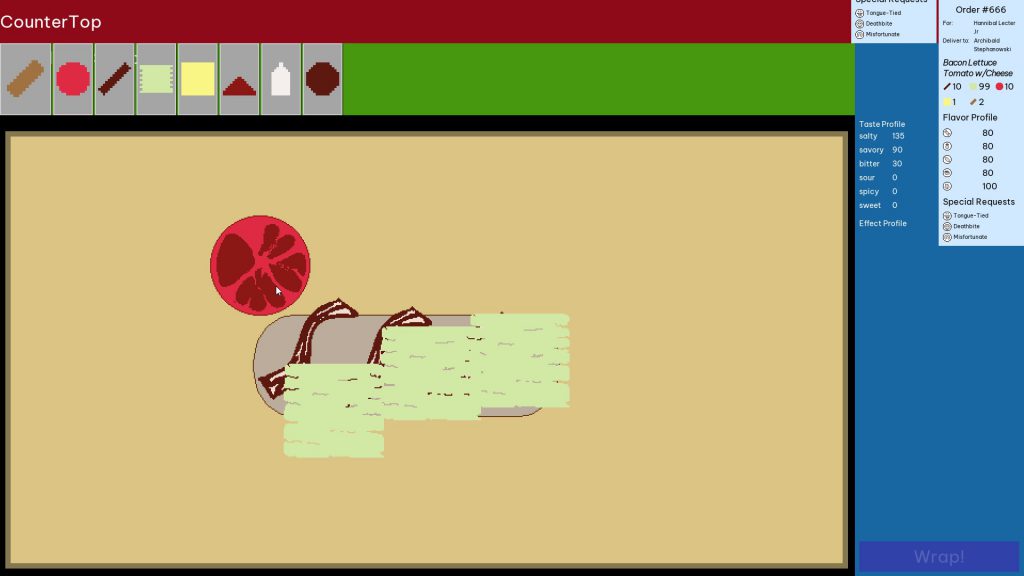
Issue: Too Much Undetected Complexity
I had no idea how complex the game we were trying to make actually was. To illustrate, these are the features which we managed to get into the game. At the time of planning, I thought they were simple:
- Sandwiches have ingredients
- Ingredients have curses
- Curses have effects
- Ingredients can also have effects
- The same effects can be assigned to both curses and ingredients
- Ingredients have individual tastes
- Sandwich ingredients are combined together to form a recipe
- They also come together to form the actual sandwich
- Both of these have a “taste profile” that is the amalgamation of all ingredient tastes
- They also have an “effects profile” that is the amalgamation of all curse and ingredient effects
- Recipe and food need to be compared to each other to determine if they are “close enough”
- All of the above needs to be represented in-game and in UI
That wasn’t even the full scope of what we had originally planned to put into the game. Other ideas include:
- Randomizing which ingredients have what curses
- Getting paid for making sandwiches
- Using earned money to choose what ingredients to buy
- Having a story about how you sold your soul to keep your sandwich shop alive
- Post-sandwich order review that included descriptions of what effects your curses had
That was a lot of complexity. It didn’t feel that way at the beginning because I didn’t think things through. The further we got into making the game, the more I realized the amount of effort needed to make all these systems and interactions work was insane.
And, because I waited so long to bring systems together, I didn’t experience this revelation until it became too late to pivot to something simpler.
Lesson Learned: Work Through Systems Implications in Advance
I need to have much better insight ahead of time where potential complexities will arise. The best way I can think about doing that is diagramming them somewhere, on paper or in a whitescreen board app, so I can visualize what systems need to interact with one another. If there’s too much complexity, then it’s a clear sign that I need to scale things back. I’ve been worried in the past that this will make the process take longer, but the consequence of not trying to do so is having things take longer anyway and not realize it until it’s too late.
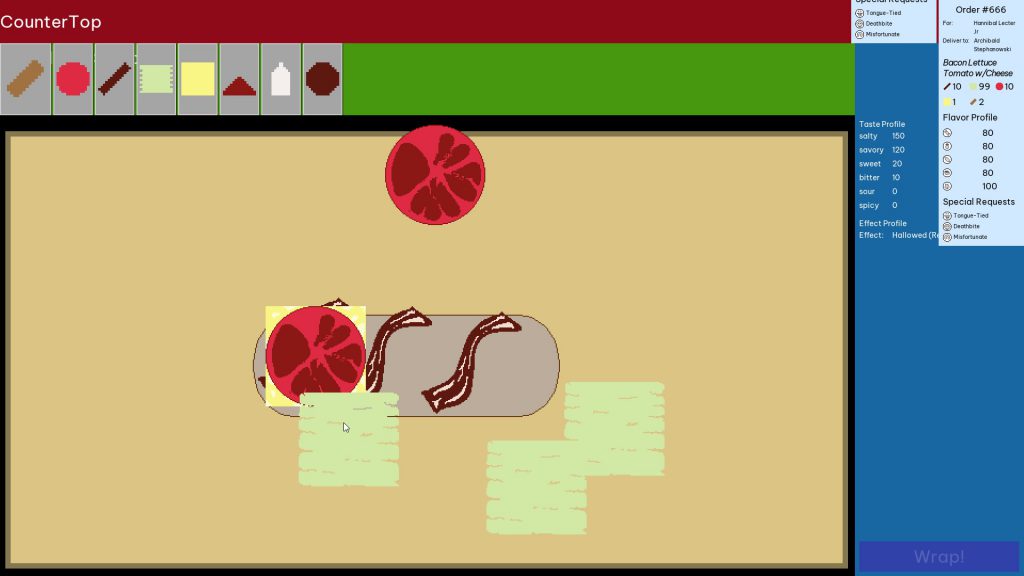
Issue: There Was No Planned Endgame
We came up with an idea for interesting gameplay, but had no concept of what the goal of the game was going to be. I kept putting a pin in it to “come back to” after the other systems were developed. Since none of the other systems were ever fully completed, we never got a chance to figure out what happens at the end.
Lacking this conceptualization of the player’s goal contributed to the underestimation of how much work was needed. There was no way to test the player could play through a core gameplay loop because we didn’t know what said loop was beyond “make a sandwich”. Without that guiding star, it was too easy to fall into a pattern of perfecting the systems with no plan for whether those systems would work well together to create a satisfying resolution.
Lesson Learned: Define the Goal at the Outset
Knowing what the player’s in-game goal is from the beginning not only gives a development target to shoot for in terms of minimum viability, but it also makes it clear what systems really need to be kept to make a fun gameplay experience. That doesn’t mean the goal has to be immutable; in fact, the goal will likely need to be simplified further as development roadblocks cut into available development time. If the goal is known in advance, though, then figuring out how to juggle all the necessary concerns should become much simpler.
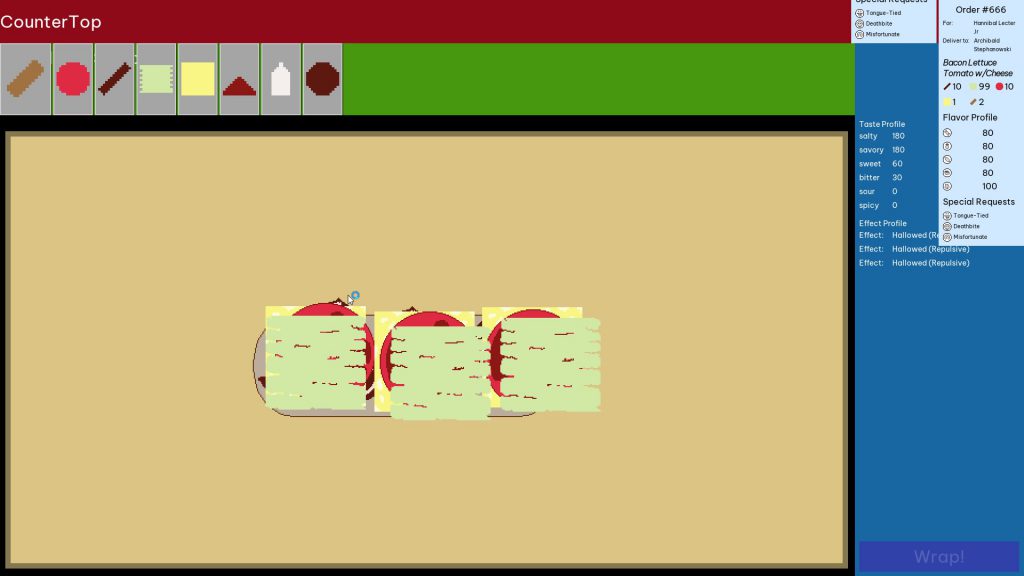
Issue: I Was Overworked
As mentioned previously, we’d spent a long time before this working on Dice Tower. In that entire time, I hadn’t really taken a break, and this caught up with me during the jam.
I’m no stranger to pushing through burnout—I don’t think I’ve ever fully recovered from burning myself out nearly a decade ago—but I underestimated how much easier it is to work through burnout when on a consistent, slow grind. When I needed to work fast and come up with good ideas quickly, my brain refused to cooperate. That’s one of the reasons I didn’t have a good grasp on how complex the ideas were: I couldn’t think far enough ahead to evaluate the consequences of those ideas, so I instead ignored that part of the process to work on the next thing necessary. The consequence of working through major burnout was significantly slowed progress, much too slow for a game jam. Subsequently, since I fell behind pace, I didn’t give myself time to rest during the jam, which only further exacerbated the mental problems I was dealing with. It was a nasty negative feedback loop.
Lesson Learned: Take a Break!
I’m bad at taking time off to actually take time off. I also know that it’s easier for me to push through tiredness and make progress if I do it consistently. But there’s a limit to how much grind I can endure, and I need to respect that. At the very least, I should take some time off from game development and other project work prior to starting a new game jam, to give myself time to recharge properly. That should hopefully make it easier for me to work and plan properly, and thus also make it easier to not feel like I’m falling behind, resulting in pacing my work schedule appropriately.
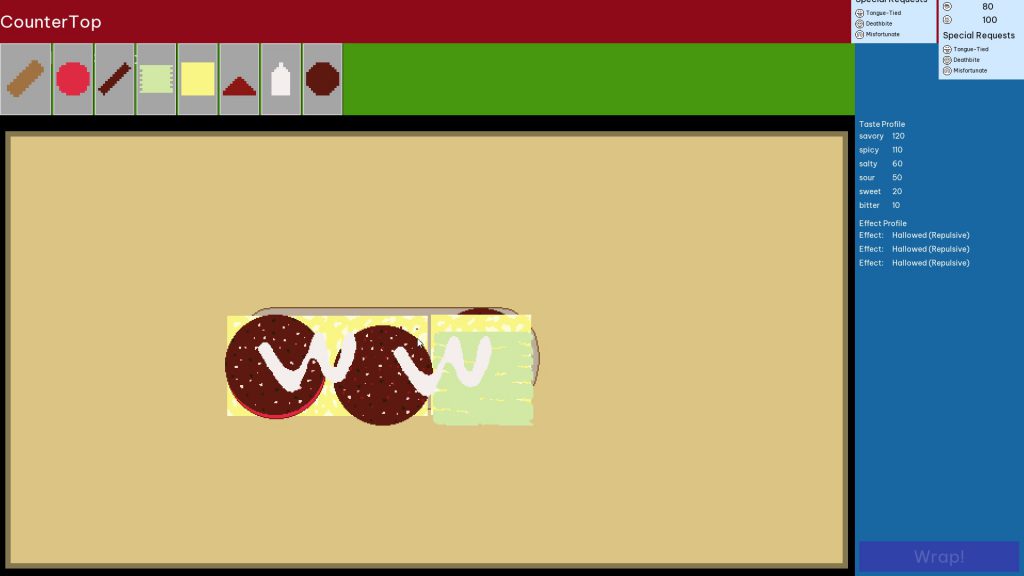
Conclusion
I entered a game jam with the intent of working on a different project which might become future inspiration. Instead, I endured an experience that revealed multiple flaws with how I approach game development. Though the experience was painful, the lessons I learned from it are valuable, and that makes me glad for having gone through it.
Lest this postmortem post make it seem like the entire project was a disaster, let me highlight some of the things that did go right:
- People liked messing around with making the sandwiches, so there is an idea there which might be worth future exploration.
- While the resource system was buggy, it did allow for relatively easy creation of ingredients, curses, and effects.
- Of all the things that got cut, at least sound and music weren’t among them this time!
Our focus is going back to Dice Tower, but we definitely intend to enter game jams more frequently in the future. Even when the projects don’t succeed in being good games, they succeed in being great teachers.

